Location
Our Washington Location
Our inpatient facility is located in Washington, and will serve Washington state. It will provide a safe & therapeutic environment for both our staff and patients.
- Edmonds
7416 212th St SW,
Edmonds, WA 98026
Disclaimer: This article is not intended as a substitute for the counsel of a qualified physician or licensed therapist. This content should be used for purely informational purposes. Please consult your doctor if you have further inquiries on this subject. We intend to impart the most accurate and recent information but cannot make any guarantees.
Addiction is not hard to find. It is plastered across every tabloid cover and celebrity news website. The story is so common, it's almost trite; another celebrity just entered rehab for the second or third time. Some might say they're not trying hard enough, or that they're too weak. They're just throwing away their fame and fortune because they're selfish. Anyone who would say a thing like that, however, has no clue what addiction is like.
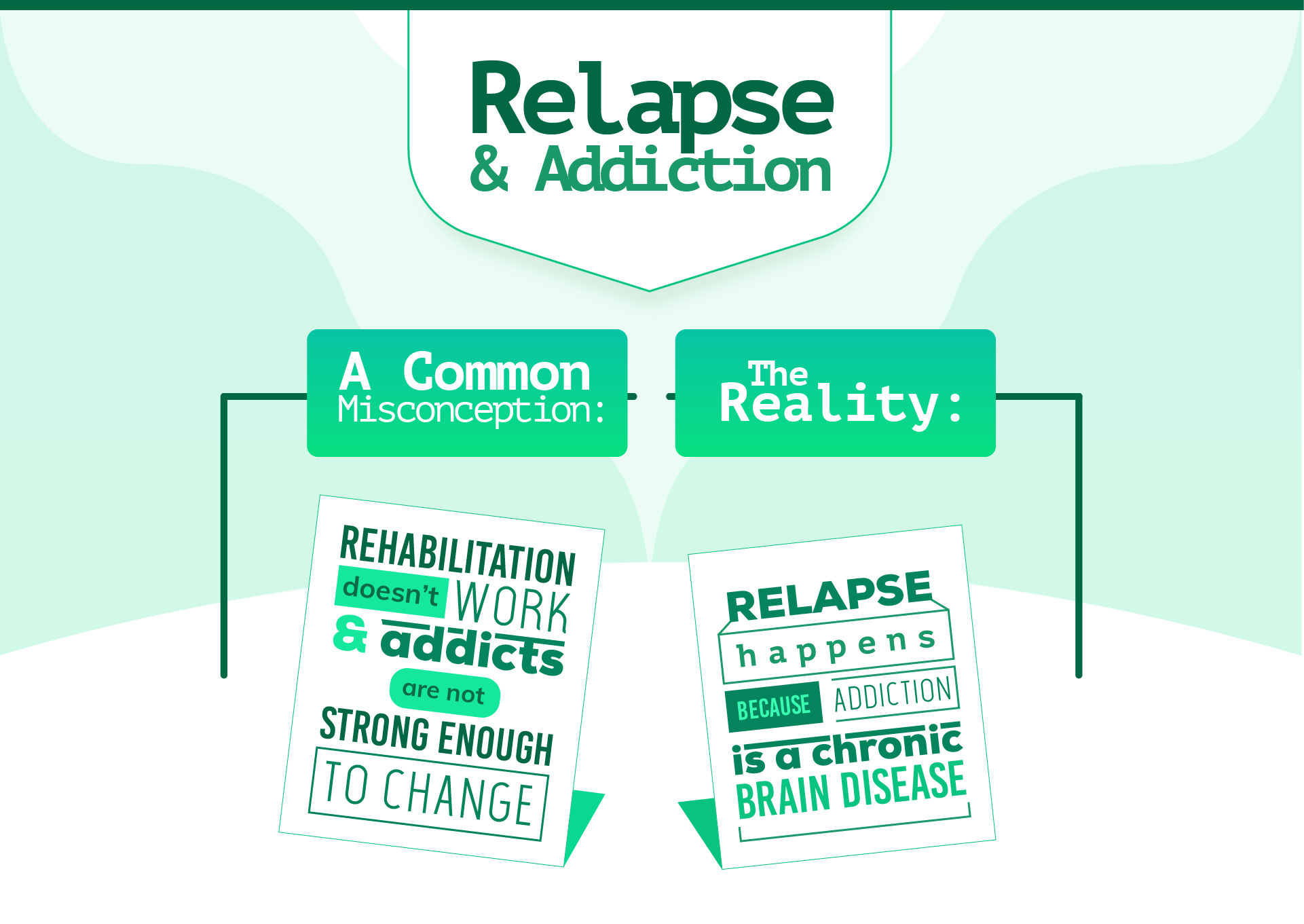
"It's time for addiction to stand up and demand some respect. Because every time someone is ostracized for being an addict, every time there's a breathless, trumped-up, sensational headline, every time we giggle at a wasted celebrity, and every time addiction is televised as salacious entertainment, yet another addict is shamed into silence."
-Kristen Johnston
It's called "revolving door syndrome" when a drug or alcohol addict completes drug rehab several times but relapses and then returns to treatment once again. This does not happen because rehabilitation doesn't work, or because addicts are not strong enough to change. Revolving door syndrome occurs because sometimes, relapse is simply part of the arduous and never-ending process of recovery.
Relapse happens because addiction, also known as substance use disorder, is a chronic brain disease. It is actually defined that way by both the American Medical Association (AMA) and the World Health Organization (WHO) - as a lifelong chronic illness. As with other chronic illnesses like diabetes and cancer, relapse is always a possibility. The good news is that even after a relapse, there is always the opportunity to detox, heal, and continue with active recovery.

Another ray of hope on an otherwise bleak situation is that advancements in medically assisted addiction treatment can provide more help now than ever before, making relapse much less likely.
Medically assisted treatment, also known as medical detox or medical intervention, refers to the use of specialized prescription medications to help people with substance use disorder achieve recovery. This article will discuss why drug and alcohol withdrawal is so difficult to bear and how medical detox makes the process more tolerable and effective for the long term.
Drug and alcohol withdrawal occur when a heavy drinker or drug user attempts to quit. This happens because heavy substance use leads to acute changes in the brain once it becomes dependent on substances to function.
Drugs and alcohol release "happy chemicals" in the brain like dopamine that create feelings of euphoria. With continued use, the brain and body become dependent on the steady influx of these chemicals and make significant changes to sensory processing and neural pathways to compensate for the effects of the substances being consumed. After awhile, these compensations become "the new normal" and the brain no longer remembers how to function without the presence of alcohol or drugs.
Eventually, the now addict will try to quit using or drinking; the brain and body will be flung into a sudden and massive chemical imbalance, and withdrawal symptoms will kick in as the body re-adjusts itself to function without the presence of illicit substances.
Since drug withdrawal symptoms are so incredibly unpleasant, many recovering addicts find them unbearable, eventually giving in to the temptation to have another dose or drink to ease the pain. For this reason, relapse is most common during the withdrawal or detox phase.
In general, drug or alcohol withdrawal lasts about seven days, but it could take longer depending on the severity of the addiction and the user's substance of choice.
Some people insist that quitting drug or alcohol abuse "cold turkey" is the fastest and most thorough way to detoxify the body after addiction. This method is not for everyone, however, and could prove downright dangerous.
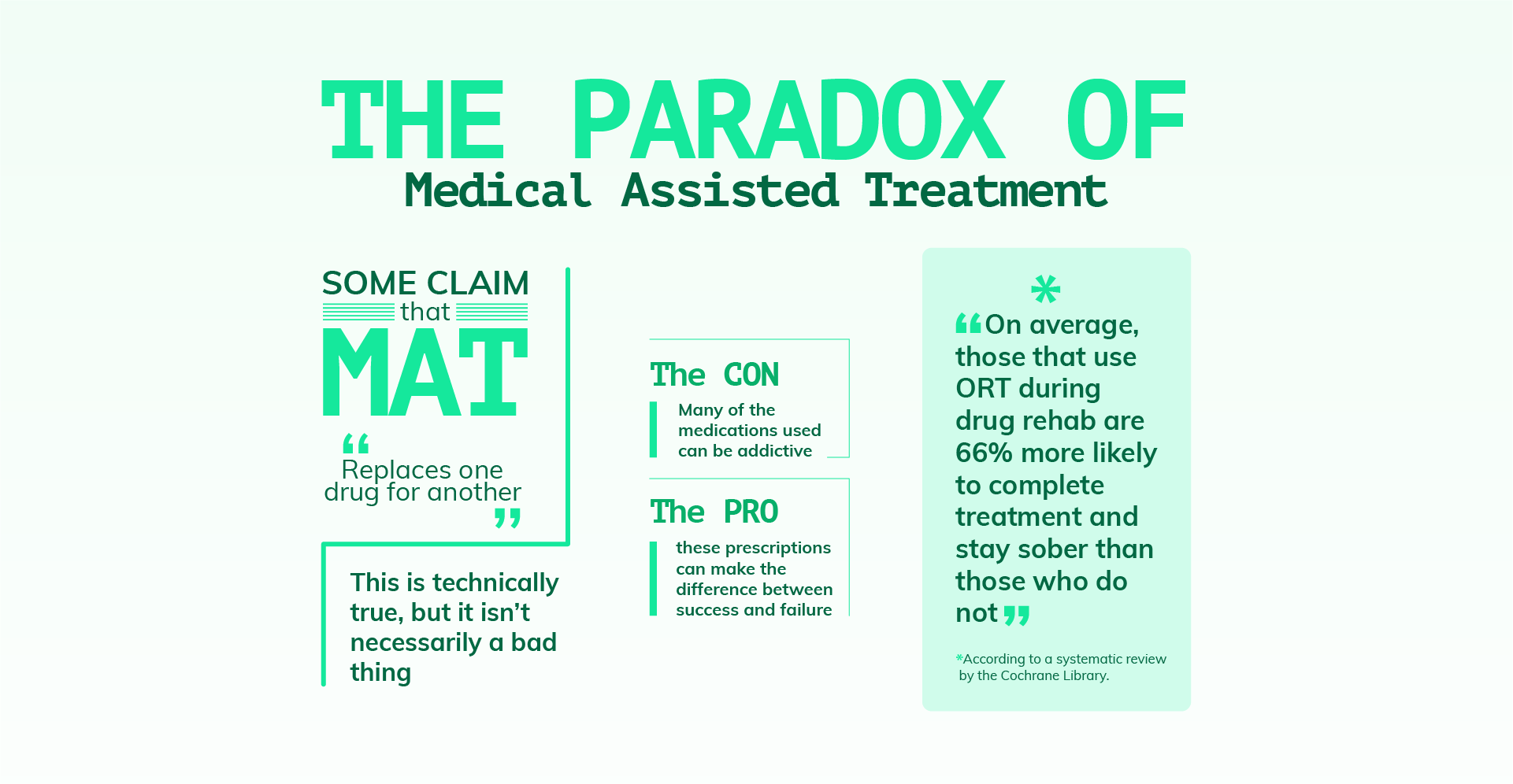
The problem with quitting cold turkey is the difficulty and misery of the process. With no medical or therapeutic assistance to help the patient withstand the painful withdrawal symptoms, the process will be even more severe and difficult to complete. Some withdrawal symptoms may even be life-threatening, and without medical assistance to recognize and treat the potential complications, quitting cold turkey may be both very difficult and very dangerous. Relapse is also much more likely during a cold turkey detox.
Below we'll present the different types of withdrawal and how they might feel for someone who decides to quit cold turkey.
Opioid withdrawal is unique in that it brings on a range of symptoms that emulate the flu or a stomach virus, so not only is the patient experiencing the psychological symptoms of withdrawal, they are also affected by a physical, debilitating illness at the same time. Here are the symptoms one might expect from opioid withdrawal:
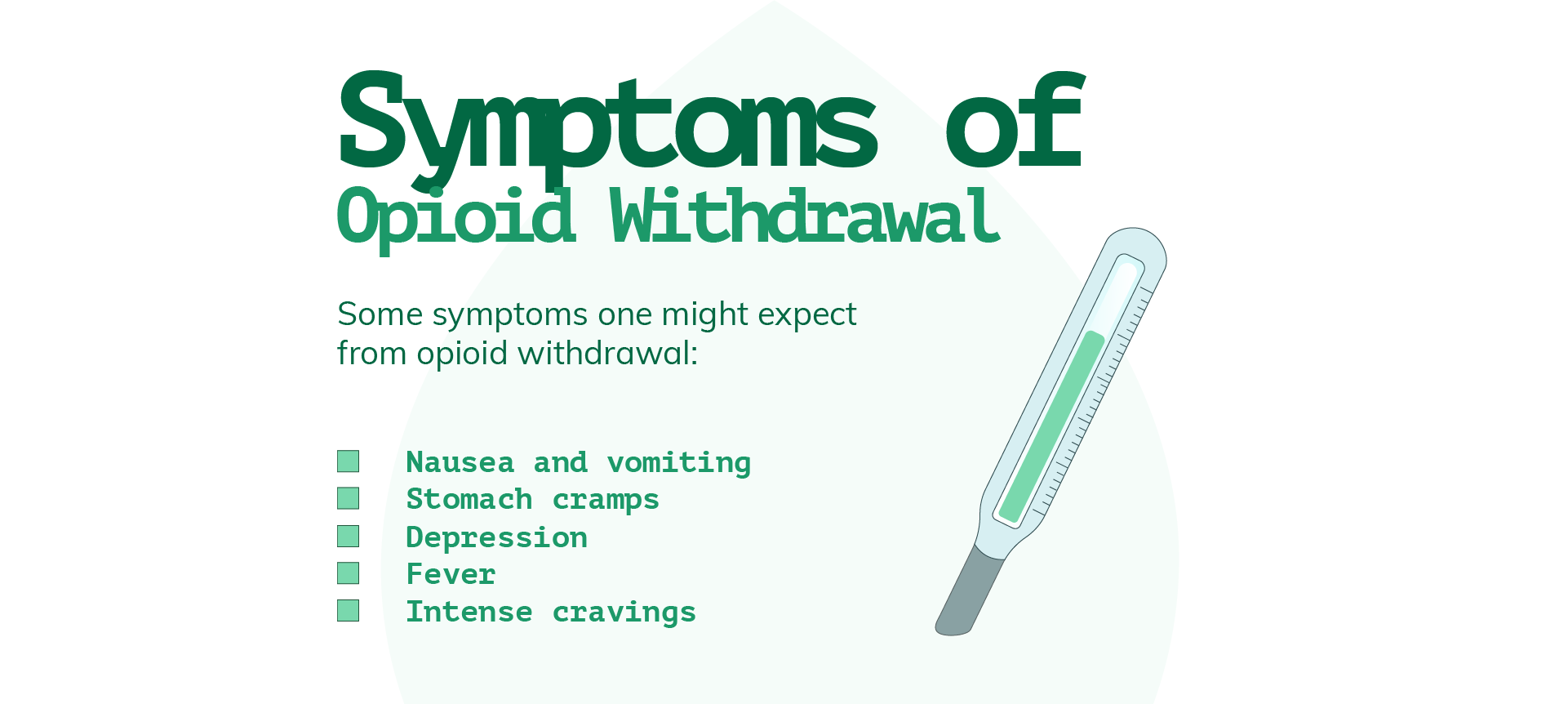
Besides the severe physical symptoms of opioid withdrawal, the process is also marked by a much higher risk of drug overdose. The reason why has to do with drug tolerance.
Drug tolerance occurs when the brain compensates for systematic drug abuse by attempting to decrease the effects of the illicit substance. Since the user can no longer feel "high" using the same dose, they continually increase the dose they take to gain euphoria, and the body continues to adjust itself to the higher doses. During detox however, opioid tolerance falls at a rapid rate, so if a user relapses to alleviate the painful withdrawal symptoms by using the same large dose as before, they are very likely to overdose because of their now-lowered tolerance.
This is one of several risks during opioid detox, and it is much safer to perform this process under the supervision of trained professionals.
Despite the fact that alcohol is not considered a "hard drug", quitting alcohol leads to one of the severest and most dangerous types of withdrawal. On average, the process lasts seven days, although the length of alcohol detox will depend on the severity of the addiction. In most cases, alcohol withdrawal will consist of some combination of the following symptoms:
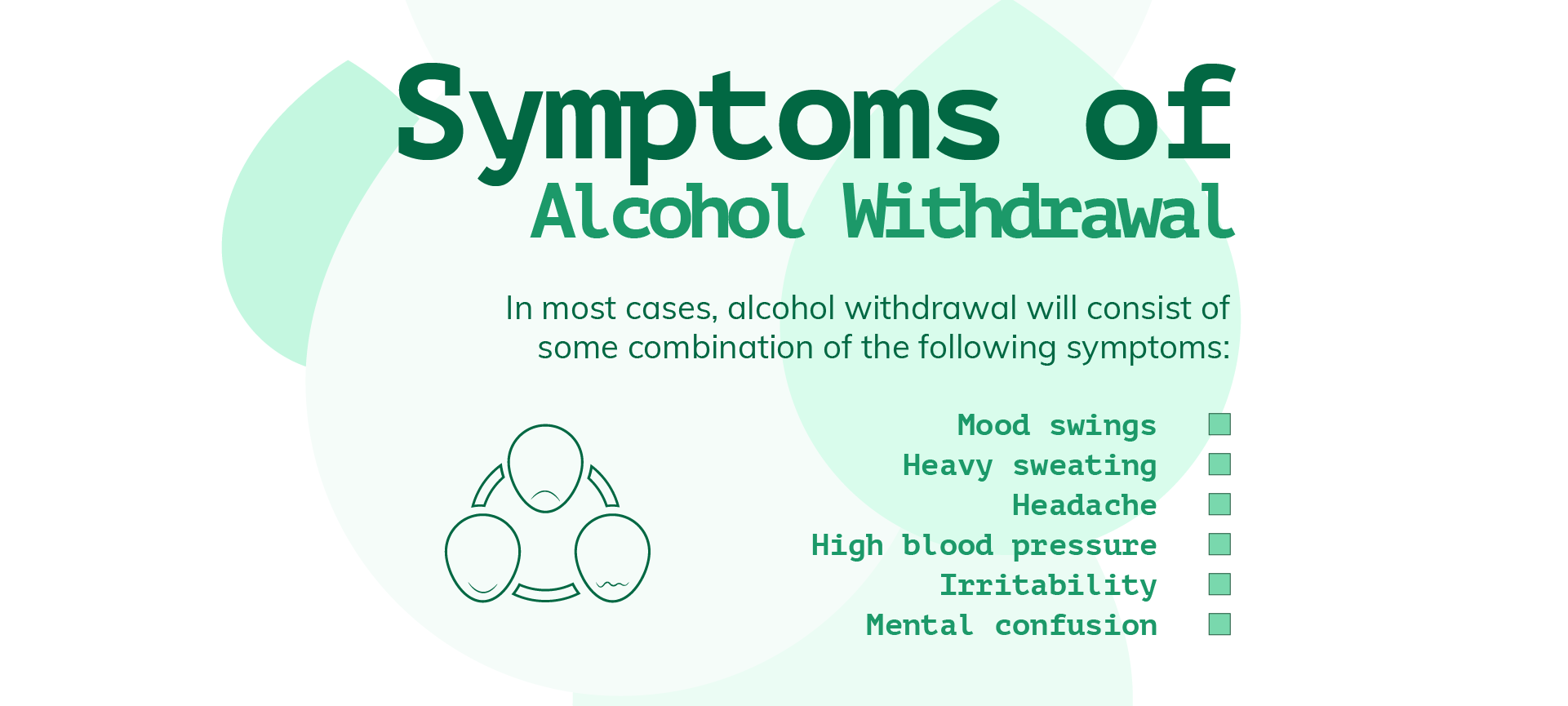
The biggest risk during alcohol withdrawal is the possibility of developing delirium tremens, a dangerous condition associated with accelerated heart rate, intense hallucinations, extreme agitation, and seizures. Without medical treatment, delirium tremens can be fatal, which is why medical supervision is recommended during alcohol withdrawal.
Every substance affects the brain and body differently, so every type of withdrawal is a different experience. Dependence to stimulants like cocaine, meth, and ecstasy causes a wide range of psychological symptoms during withdrawal. This is what one might expect during stimulant withdrawal:
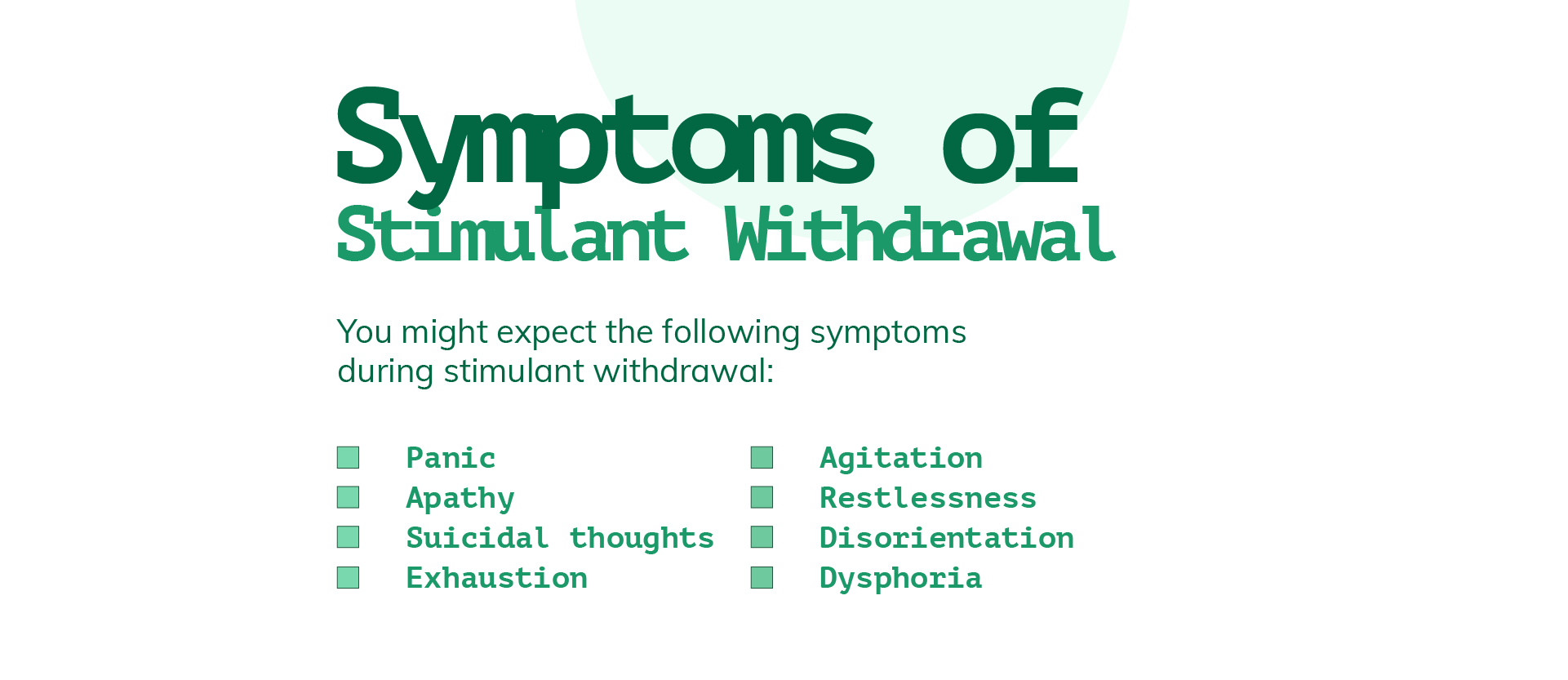
Because of the psychological nature of stimulant withdrawal symptoms, the greatest risk during this type of detox is suicide or self harm. Even those patients who had no previous indications of mental illness or suicidal tendencies may lose touch with reality during detox. Round-the-clock supervision is recommended for severe stimulant addicts during detox.
Managing withdrawal symptoms is key to completing the detox phase successfully, which is why a little help goes a long way. Without therapy, exercise, medical intervention, and support, a patient will have nothing to focus on besides the pain and misery of their symptoms.
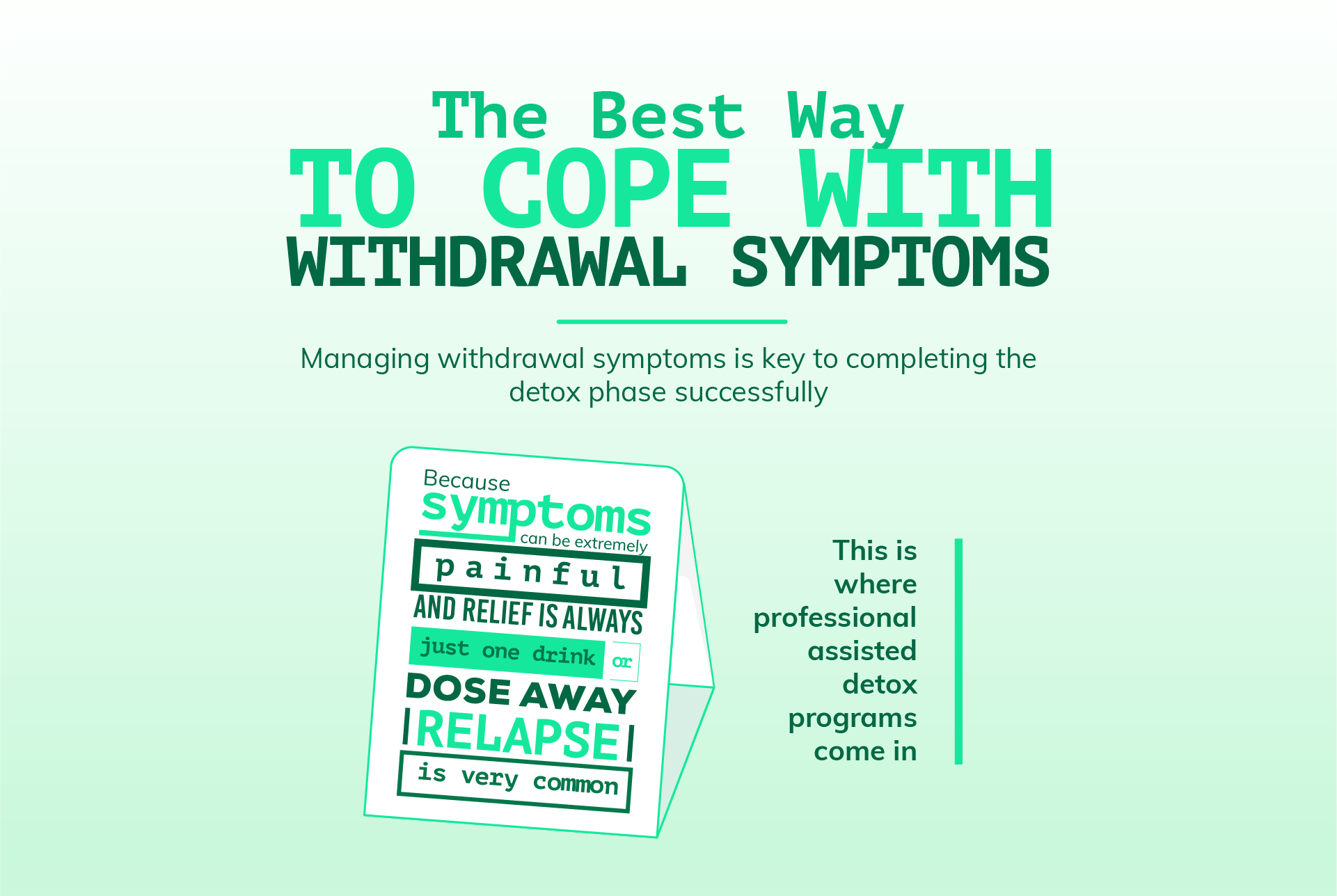
That is why relapse is most common during withdrawal; it simply seems too difficult and painful to bear. When relief is only one drink or dose away, many feel that they cannot withstand the process for the full week or more that is required to complete detox. This is where professional assisted detox programs come in.
In a professional detox program, patients have access to a variety of medical prescriptions, treatments, and therapeutic activities to soothe withdrawal symptoms as well as to keep the body and mind focused on healthy diversions. Some of the detox treatments that may be offered in a professional drug and alcohol treatment center are:
While some of these treatments could be completed outside of a professional rehab center, medical intervention is considered to be the most beneficial and is only available under close medical supervision.
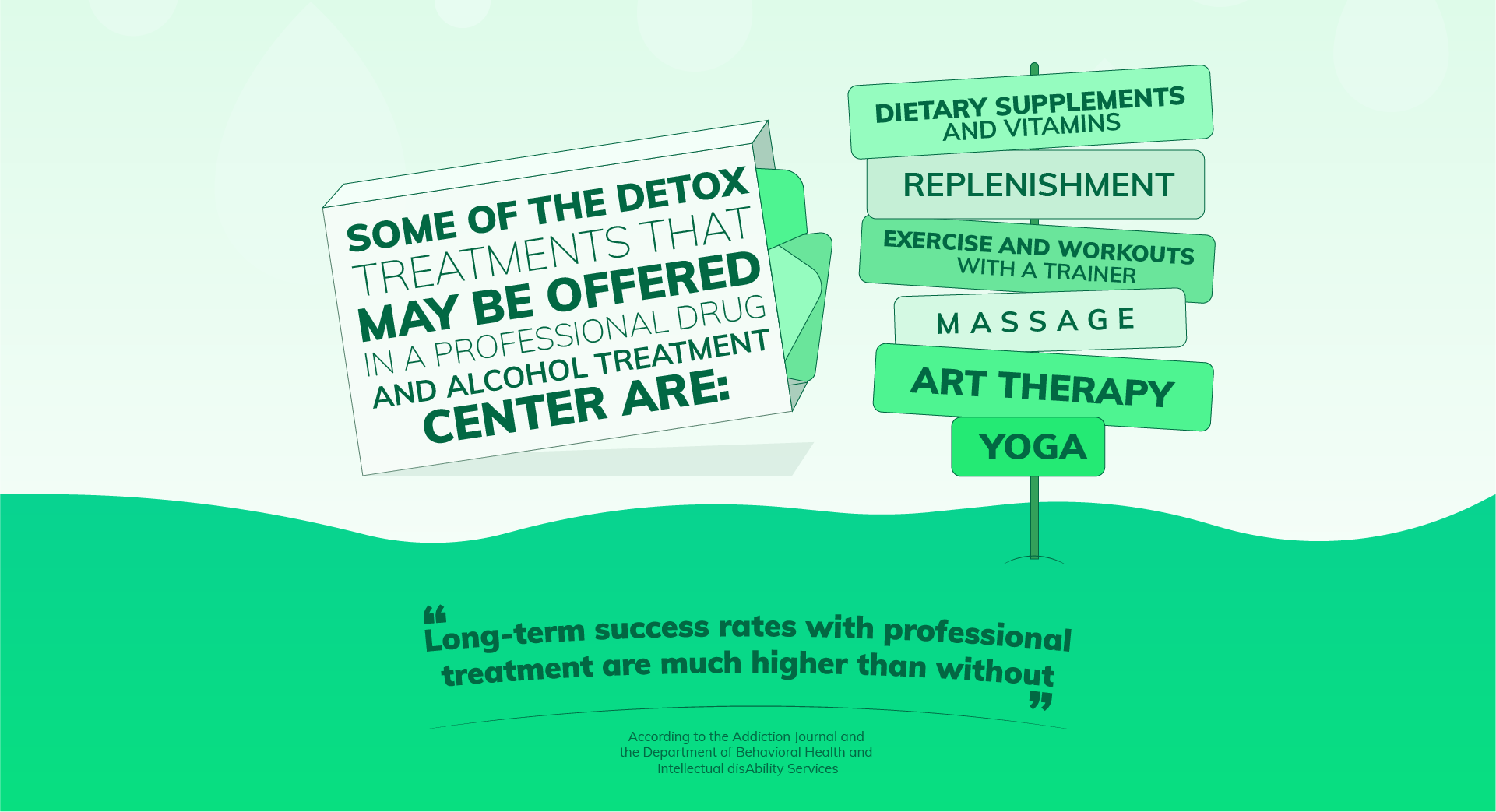
There are a wide range of benefits to be gained by attending a professional detox and rehab center to get clean. For one thing, long-term success rates for those who seek professional addiction treatment are much higher, according to Addiction Journal and the Department of Behavioral Health and Intellectual disAbility Services. Here are some more advantages offered by professional drug rehab centers:
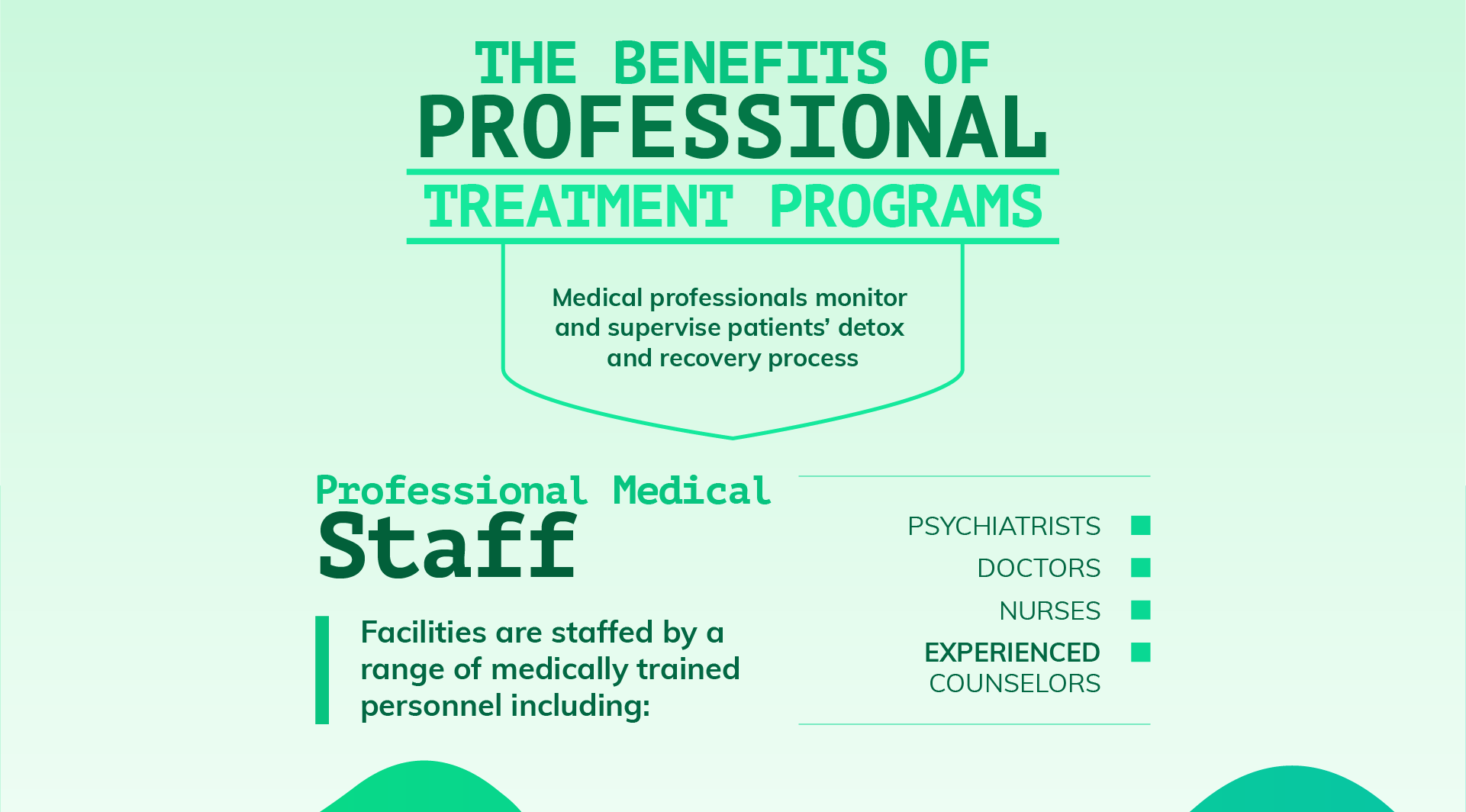
A quality addiction treatment facility will be staffed by a range of medically trained personnel, including psychiatrists, doctors, nurses, and experienced counselors. Professionals like these will be able to prescribe the the right medications, monitor and analyze progress, and recognize potentially dangerous withdrawal symptoms early on.
With medical professionals to monitor and supervise a patient's detox and recovery process, treatment plans can be made, adapted, and adjusted to match the individual's symptoms and progress.
Dual diagnosis is the practice of examining the mental, emotional, and social patterns of an individual to determine if any mental illness or disorders may be contributing to their addictive behaviors. More than half of all people with substance use disorder also suffer from other mental, emotional, or social conditions.
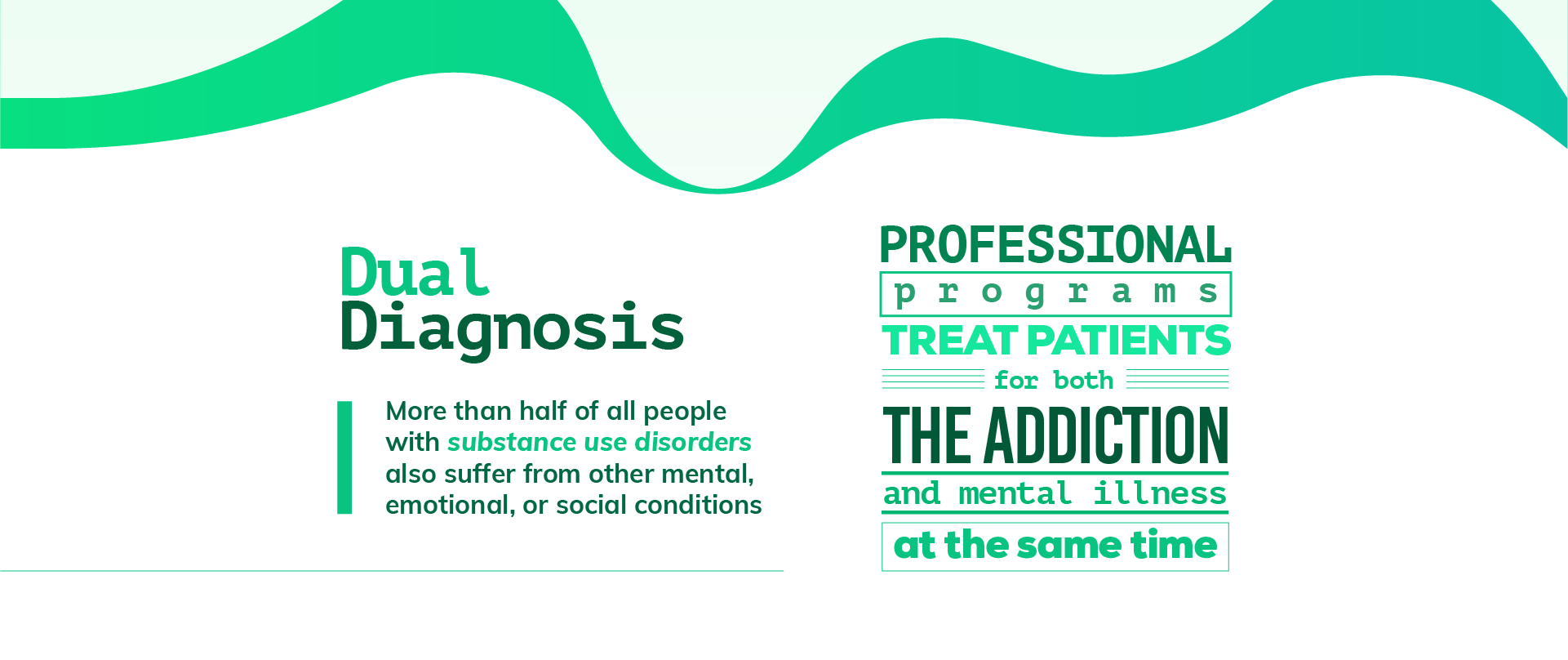
If a patient is suffering from co-occurring disorders along with addiction, their chances of recovery are much higher if they are treated for both the addiction and mental illness at the same time. A dual diagnosis will also affect away the patients experience and manage withdrawal symptoms during detox.

Whether detox is performed with medical assistance or cold turkey, it is not the end of the recovery process. On average, only 15% of individuals who complete detox alone stay clean, while 45% or more of those who complete full rehabilitation programs achieve long-term sobriety.
The reason for this is that detox only eradicates the physical addiction, but substance or alcohol use disorder is much more than a physical condition. Once detox is over, it is imperative to also address the psychological side of addiction and prepare the mind and body for the challenges of a newly sober lifestyle. That is where rehab comes in.
In a full-service drug rehabilitation center, the patient will be slowly transitioned into rehab treatments as the symptoms of withdrawal begin to abate. Day by day, the patient will be given more activities and therapy sessions until, by the time withdrawal is over, they are immersed in a full-time rehab treatment schedule.
For a better chance at success, it is recommended that a recovering addict enter a rigorous alcohol or drug treatment program during or immediately after detox, which is why completing the entire process at a residential care facility is ideal.
If recovering from addiction were easy, medical detox wouldn't exist. The fact is, drug and alcohol withdrawal is so painful, difficult, and dangerous that many addicts who attempt it cannot finish successfully on their own. Medically assisted treatment is a way to make the harrowing process safer and more bearable for a higher chance of success.
Medical intervention during drug or alcohol detox can soother the severity of withdrawal symptoms, prevent some dangerous withdrawal conditions like delirium tremens, and reduce cravings, among other things. Dosages and side effects vary from one patient to another however, so it is important to always perform medical detox under the recommendation and supervision of a medical doctor. Below we'll go over some of the different prescriptions that are used to treat withdrawal symptoms.
Since opioid relapse presents the highest risk of overdose, it is especially important to reduce cravings and prevent relapse during opioid withdrawal. For this reason, Opioid Replacement Therapy (ORT) is the most popular form of medically assisted treatment during opioid detox. The medications used in ORT are especially effective in preventing the painful symptoms from becoming severe and reducing the intense cravings associated with opioid withdrawal.
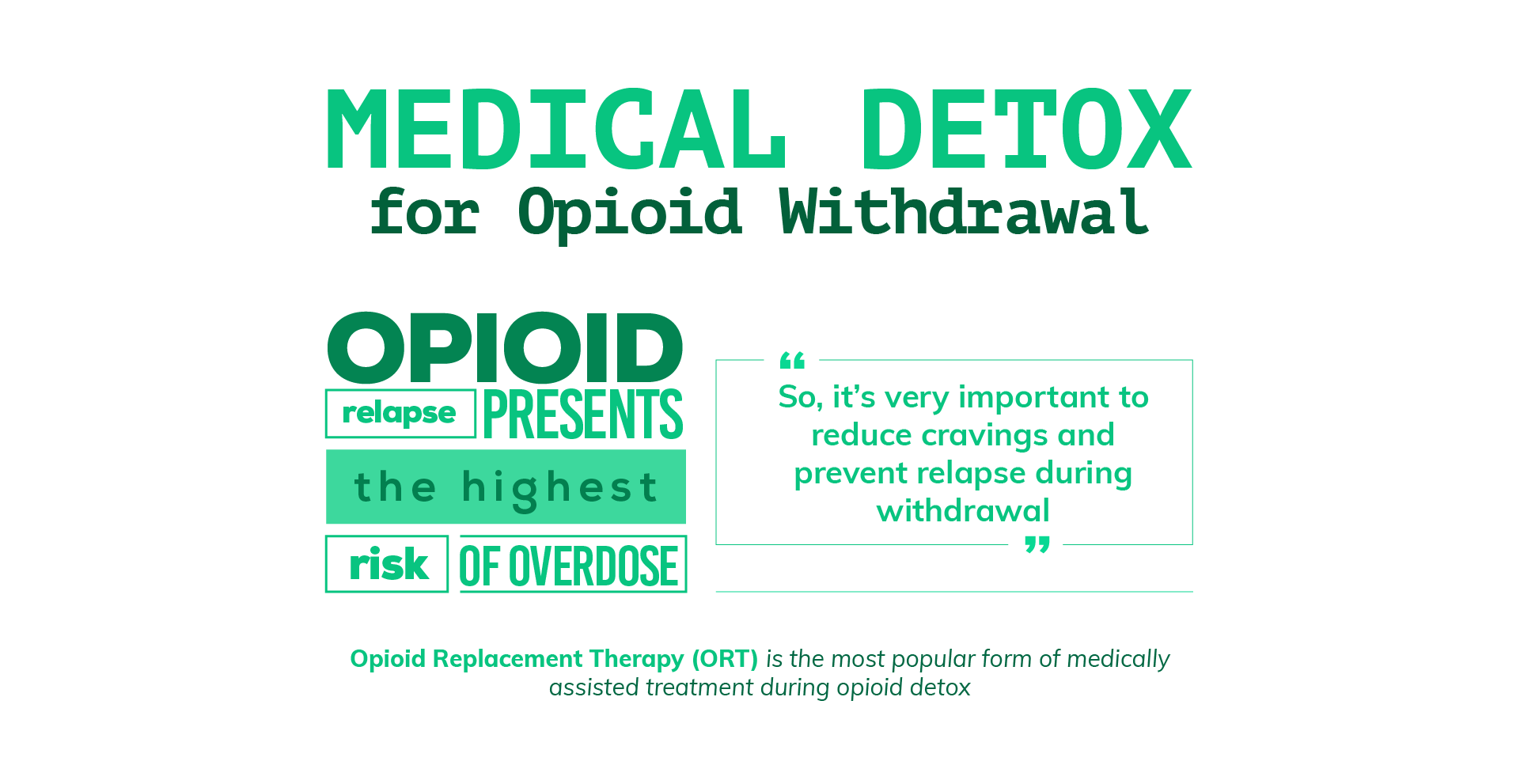
For decades, methadone has been used to facilitate the opioid detox process because it is useful for alleviating the agonizing symptoms of opioid withdrawal. Since methadone deceives the brain into thinking it is still receiving opioids, full withdrawal symptoms do not kick in as the brain rids itself of its dependence to opioids.
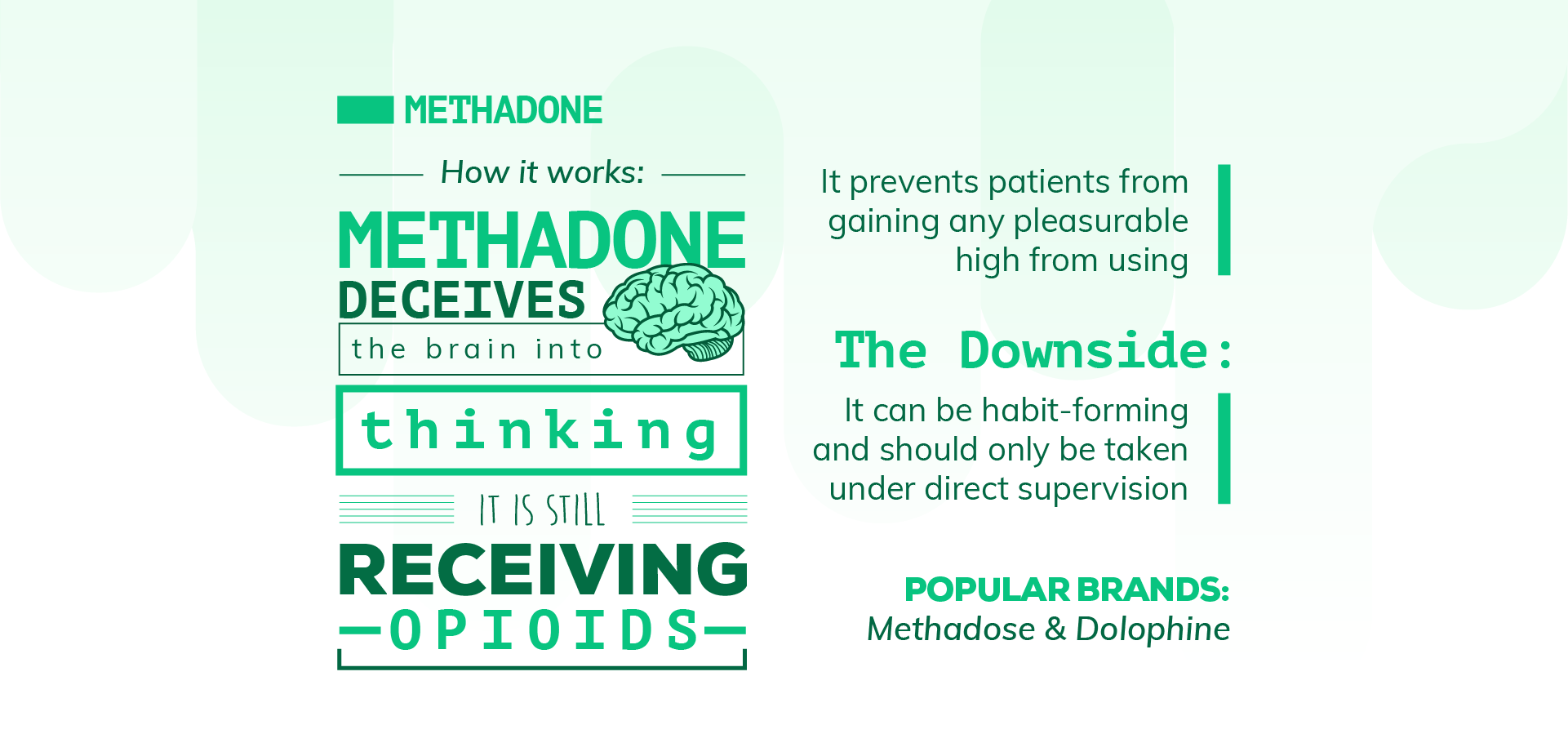
Another benefit of methadone is that it blocks opioid receptors in the brain and prevents patients from gaining any pleasurable high from the use of opioids. This reduces cravings as well. The downside to methadone is that it can be habit-forming and should only be taken under direct supervision. The two brands that produce methadone are:
Buprenorphine performs the same functions as methadone but with a slightly milder effect. Because it is not as potent, buprenorphine is not as addictive as its stronger counterpart. Despite this, the medication appears to work equally well in staving off most opioid withdrawal symptoms and cravings during detox, while also presenting less risk of abuse or overdose. There are several different ways to take buprenorphine:
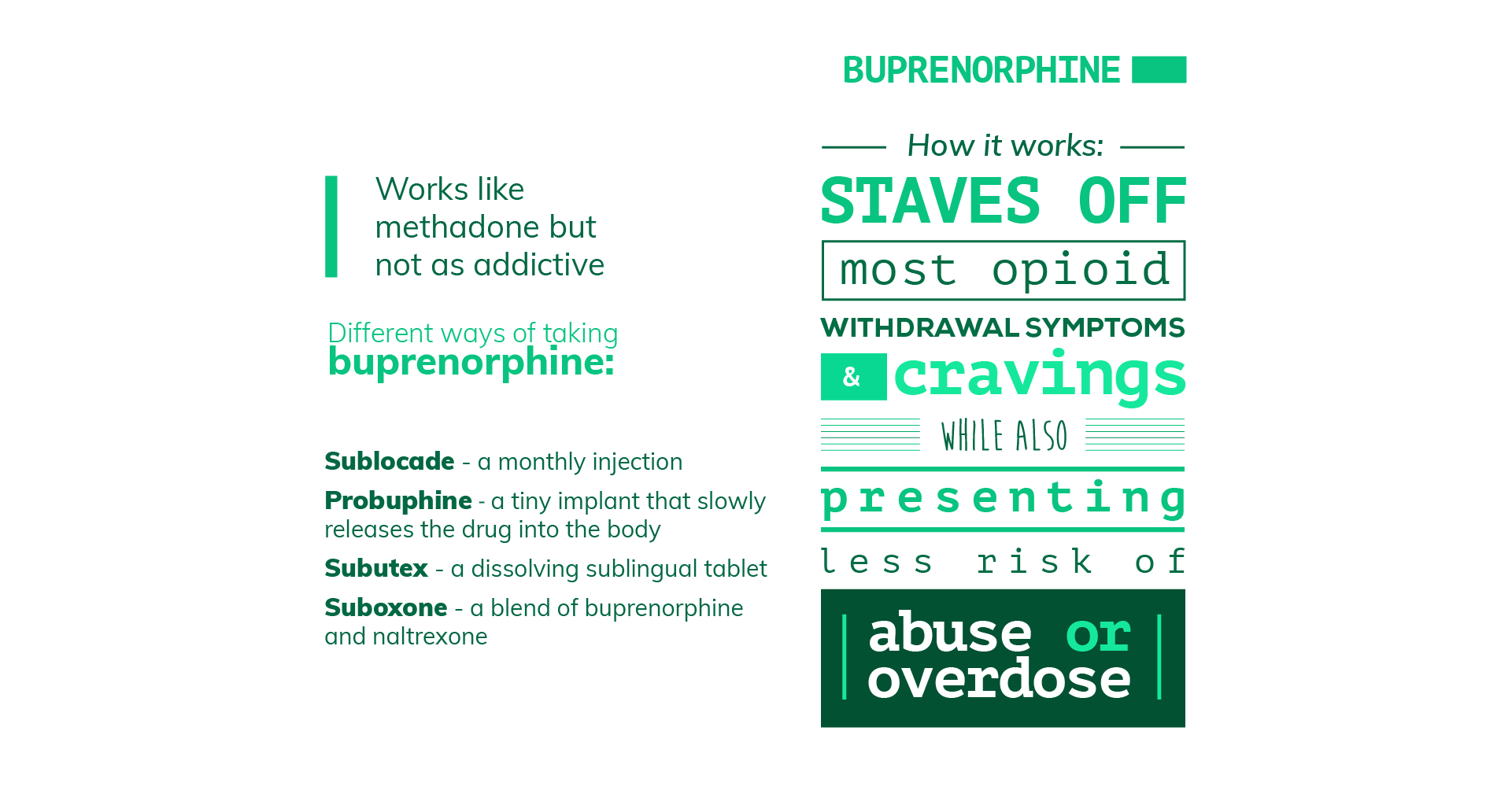
Also used to treat alcohol withdrawal, naltrexone functions equally as well for opioid addicts. The substance binds to opioid receptors and completely blocks the release of happy chemicals in response to opioid use. After a short time taking the medication, the brain will stop associating opioids with pleasure, effectively putting an end to addictive behaviors and cravings. The two brands of naltrexone are:
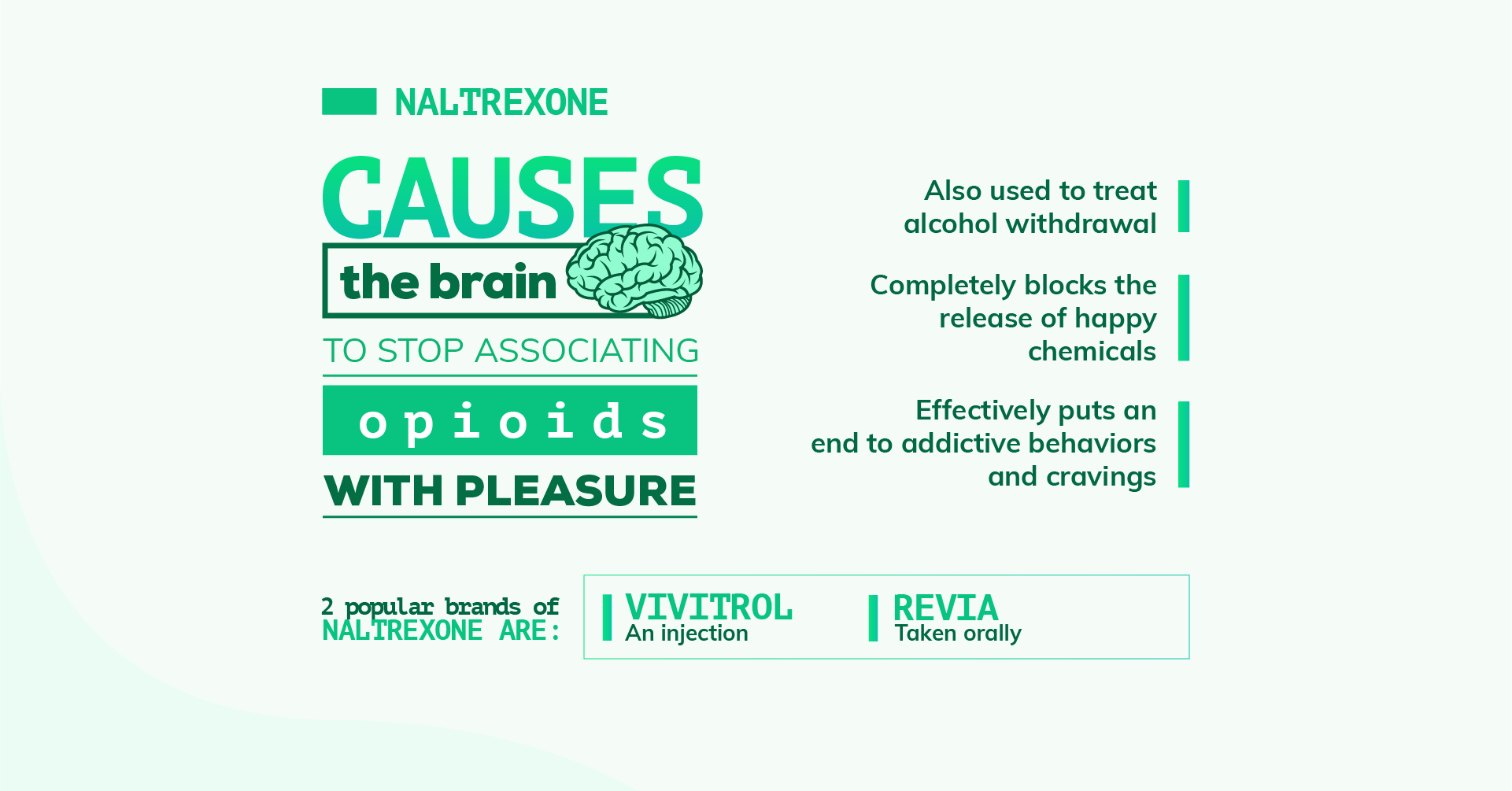
During alcohol withdrawal, medical detox will serve several important objectives; to reduce cravings, to decrease alcohol's pleasurable effects, and to prevent some of the worst withdrawal symptoms from becoming too severe or dangerous:
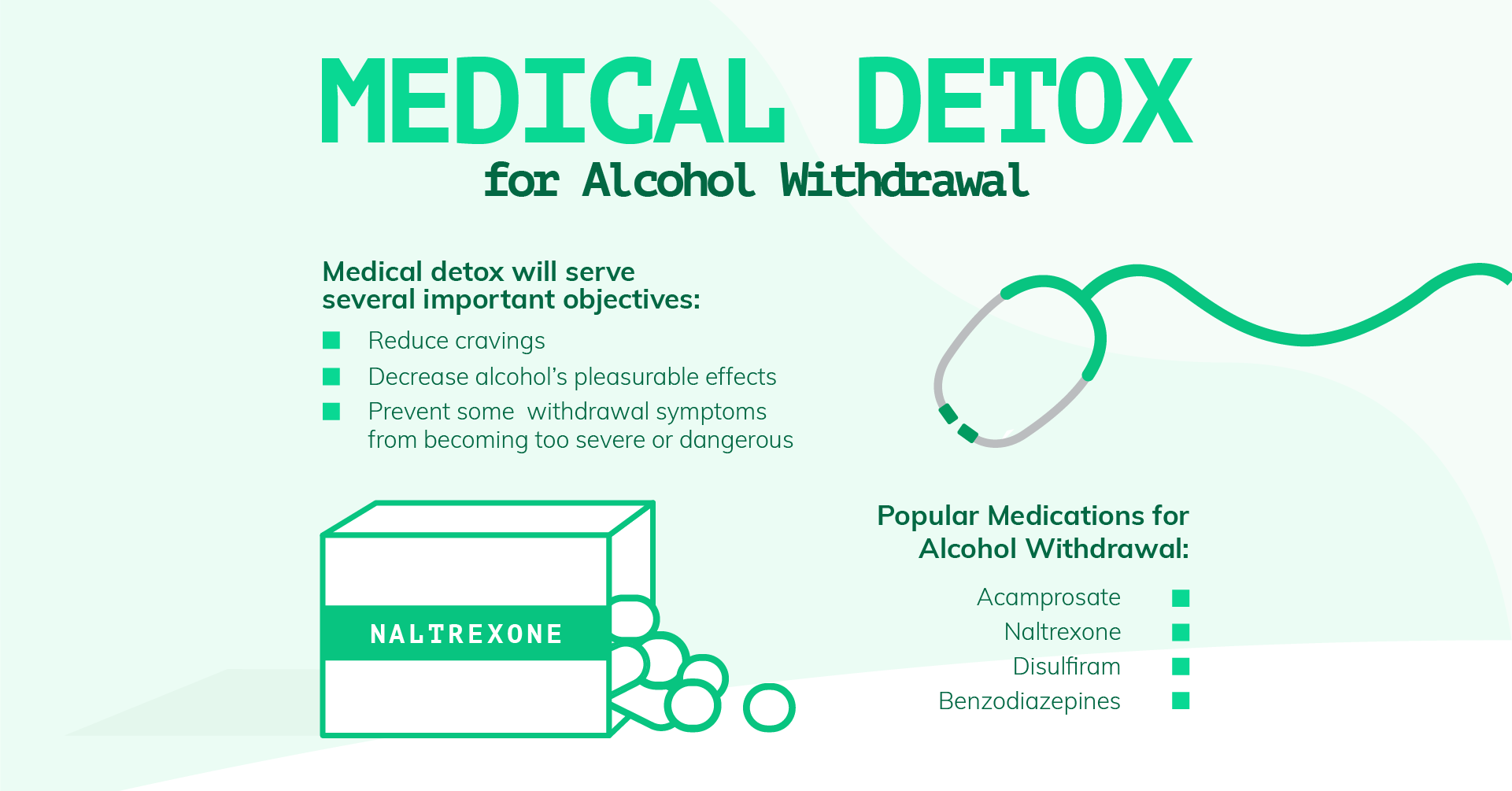
This mild sedative has a balancing effect on the alcohol-ravaged brain, especially for patients who have long histories of alcohol abuse. Acamprosate counteracts some of the chemical effects that alcohol has on the brain and reduces cravings. Campral is the only known brand name of the medication acamprosate.
Used for both opioid and alcohol withdrawal, naltrexone is gaining great popularity in addiction treatment because of its surprising ability to completely neutralize the effect alcohol has on the brain. By removing the euphoria and pleasure associated with alcohol, naltrexone takes away its addictive power and pacifies cravings. If taken correctly, the medication also greatly reduces the chances of relapse.
Disulfiram is designed to create a negative association with alcohol, in order to decrease cravings and addictive patterns. If a patient drinks alcohol while taking disulfiram, they will soon be afflicted with a range of severe side effects similar to those suffered from a bad hangover - headaches, nausea, vomiting, and weakness. The experience is unpleasant enough that the brain will soon begin to associate alcohol with getting sick and will cease to crave it so badly. The brand name of disulfiram is Antabuse.
Benzodiazepines include several types of anti-anxiety medications that be used to treat a variety of withdrawal symptoms. In cases of severe alcohol withdrawal that brings on seizures or delirium tremens, benzos may prevent the symptoms from becoming fatal. Since these medications can also be addictive if abused, they should only be used when needed and under medical supervision. Ideally, benzos would only be used during the worst period of alcohol detox and tapered off quickly as withdrawal symptoms diminish. These are the most common types used during alcohol detox:
Unlike opioid and alcohol addiction prescriptions, no medications have been approved by the FDA to be used specifically for use during stimulant withdrawal. However, there are several solutions that doctors implement to facilitate the detox process for those in recovery from stimulant addiction. By treating some of the specific symptoms of stimulant withdrawal, medical personnel can make the process more bearable. These are some of the medications that can be helpful during stimulant withdrawal:
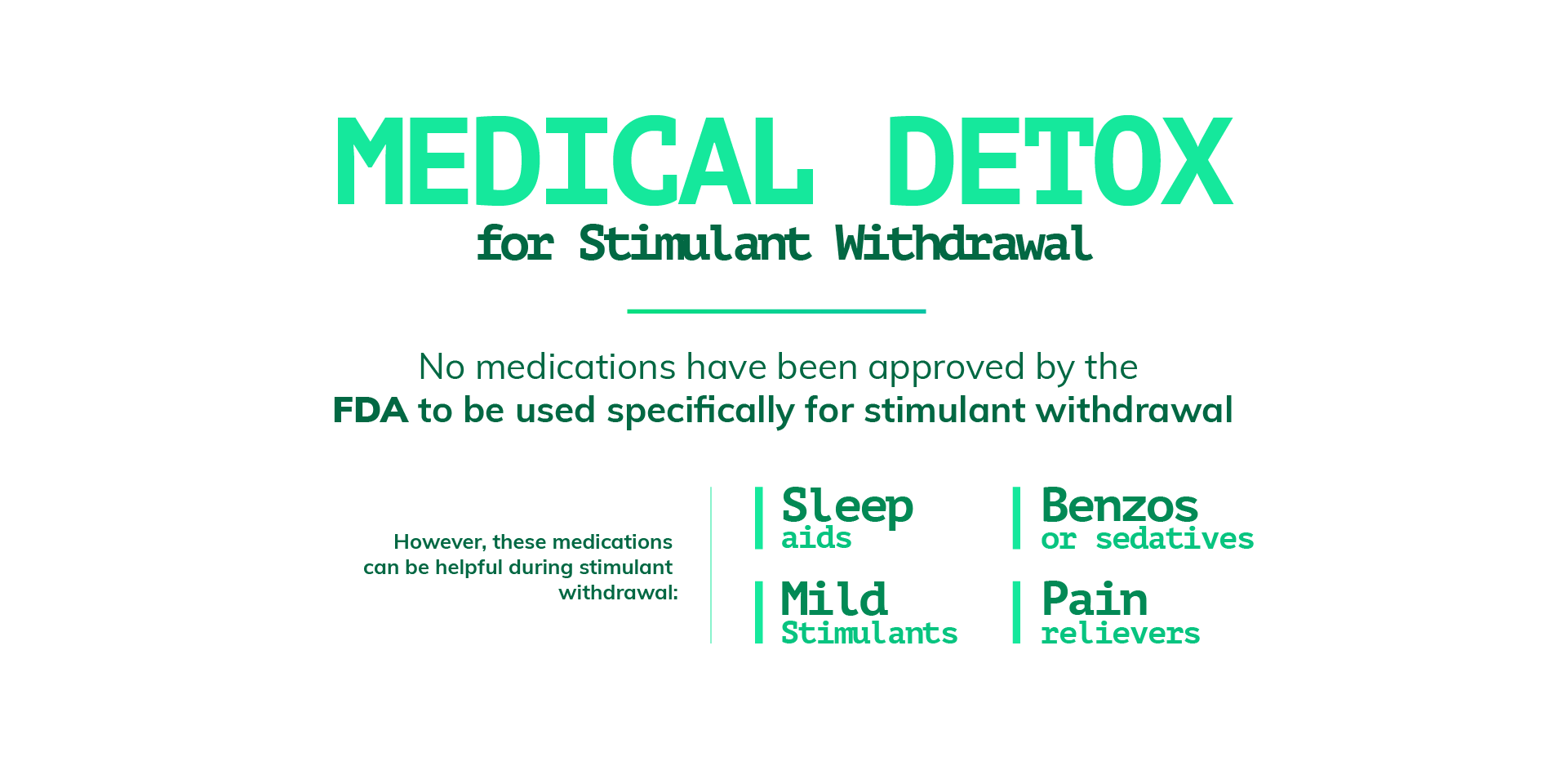
Medically assisted treatment has garnered some criticism in the mental health industry because of claims that the practice "replaces one drug for another". Although this is technically true, it is not necessarily a bad thing.
First, it is important to recognize that many of the medications used in medical detox, such as methadone, sleep aids, and benzos, can be addictive. This is the reason that some medical professionals disregard their use as harmful. The fact is, for many recovering addicts, these prescriptions are the difference between success and failure. On average, those that use ORT during drug rehab are 66% more likely to complete treatment and stay sober than those who participate in non-medicated drug treatment, according to a systematic review by the Cochrane Library.
With numbers like that, it's hard to argue with the fact that medically assisted treatment is effective in helping people achieve sobriety. The potential risk of forming a new addiction is not to be discounted, however. Currently, prescriptions of methadone, benzos, and similar medications are only distributed in highly controlled environments and monitored closely. Research on less addictive solutions like Suboxone are also underway.
In full-service drug and alcohol rehab centers where medical detox is part of the program, recovering addicts are able to complete the difficult processes of detox and rehab in a more comfortable and results-driven environment, but doctors are aware of the risks. The goal in most medical detox and ORT treatment plans is to taper off the medications as soon as withdrawal symptoms begin to ebb, with the end goal being that the vast majority of patients are free and clean of any medication dependencies before their release date.
The great exception to this rule are those individuals who suffer from co-occurring mental illness and substance use disorder. For some dual-diagnoses, patients will need to continue taking psychiatric medications to manage their mental illness indefinitely in order to successfully manage their addiction.
Many recovering addicts wish to complete the detox stage "in the comfort of their own homes", but going through withdrawal at home - especially medically assisted withdrawal - is far from comfortable and not recommended for several significant reasons:
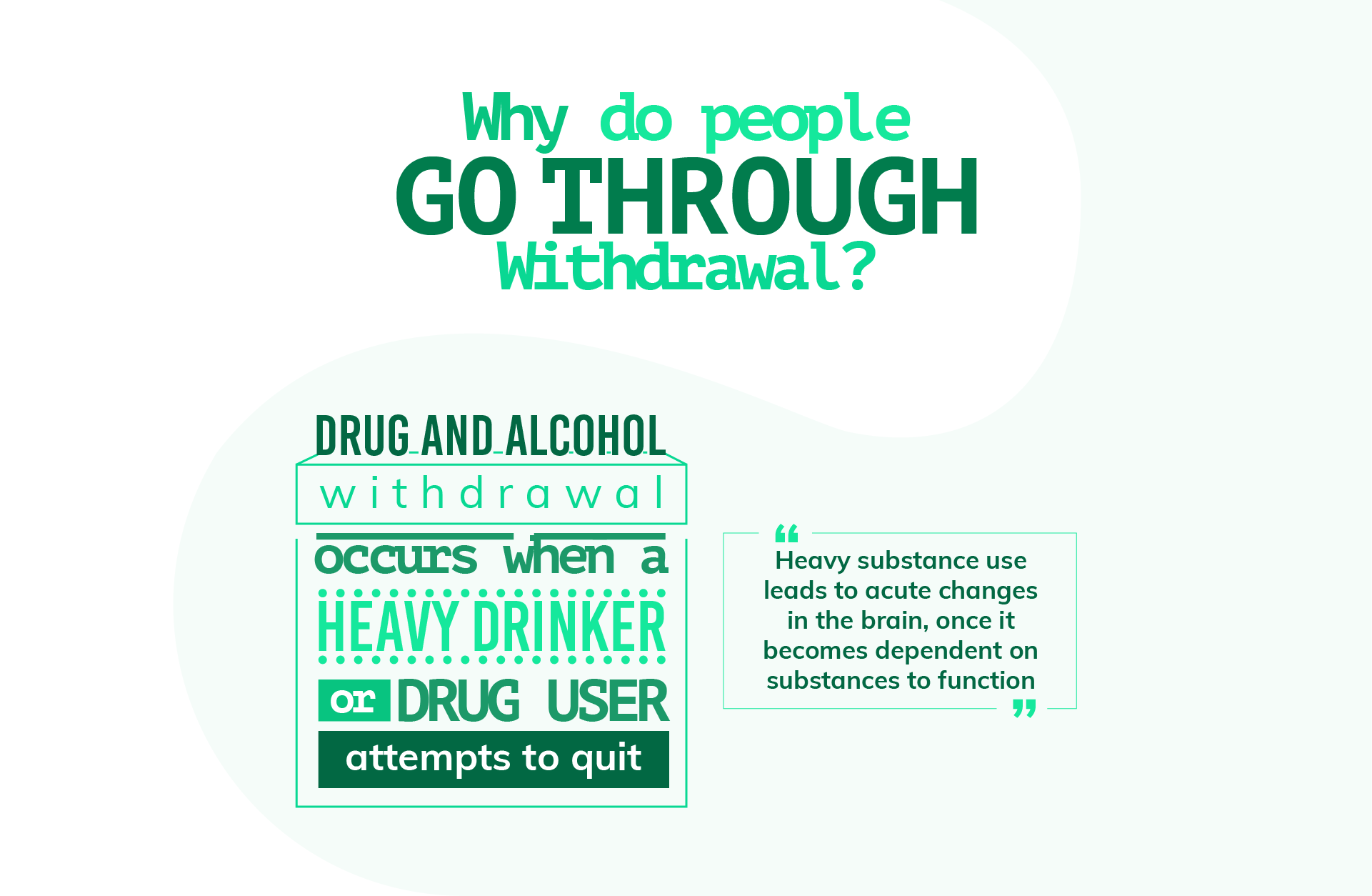
There are some addiction specialists and drug or alcohol addiction treatment centers that do offer medically assisted treatment as an outpatient program, however. If a patient is determined to complete detox at home, it is technically possible, but certain precautions would be necessary for the safety of the patient. For example, some doctors offer monthly injections or similar solutions that have a lower chance of creating addiction or abuse.
For anyone who plans to attempt medical detox at home, the following precautions should be taken for a higher chance of success and to lower potential risks:
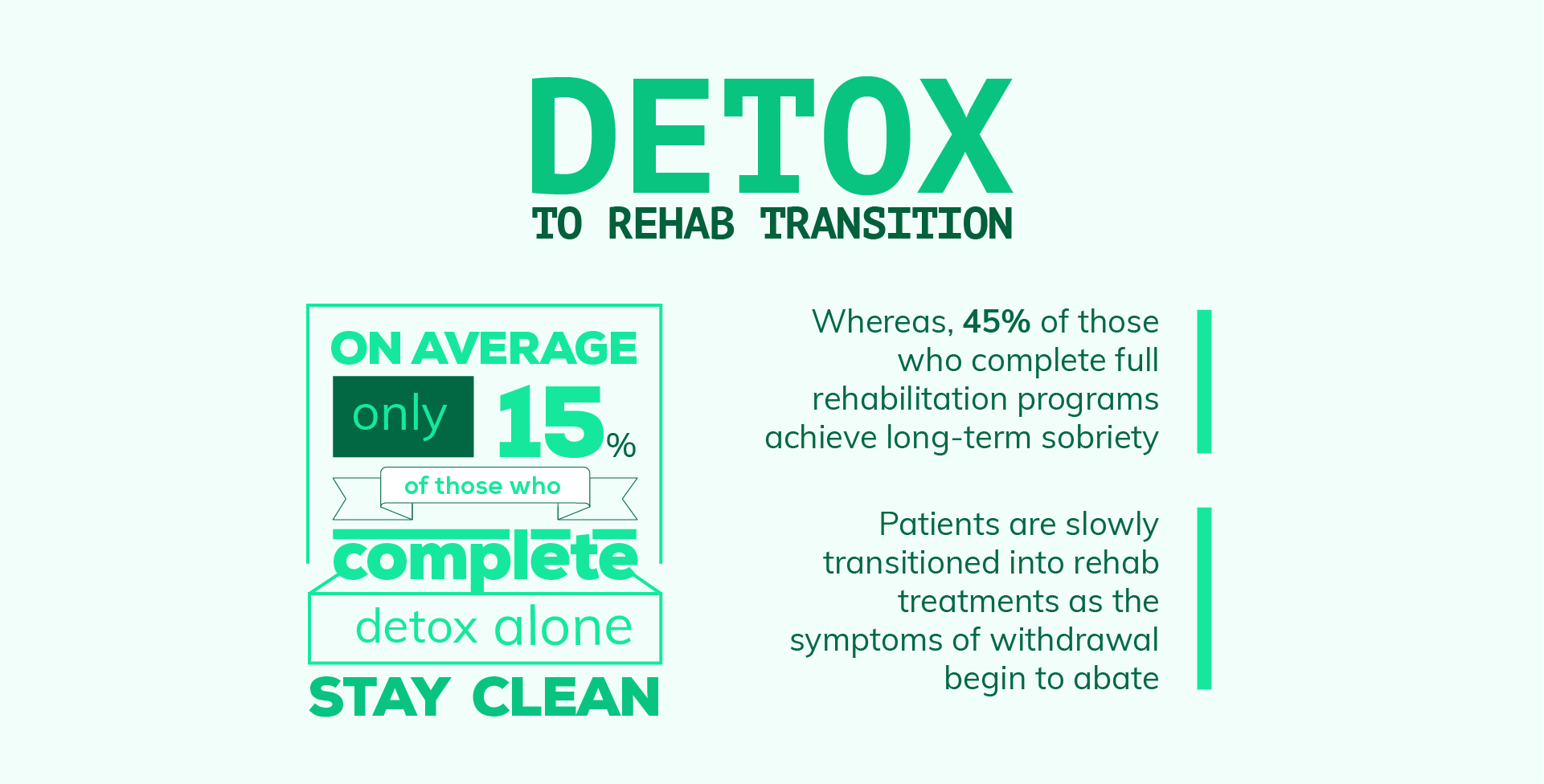
If you've read this far, it's safe to assume that you or someone you love may be suffering from drug or alcohol use disorder. Perhaps you've tried different types of treatment but so far, nothing has worked out long term. Medical detox is a viable option for even the most severe addictions, but it is not an end-all solution.
It is important to keep in mind that substance use disorder is a disease without a cure. It will never go away and it will always affect how you live your life. For the best chances of staying sober for the long-term, it is imperative to complete a rehabilitation program as well as detox, ideally during or immediately after the withdrawal period ends. This is because medical detox only addresses the immediate physical side of addiction, but not the deeper psychological addiction that lies beneath.
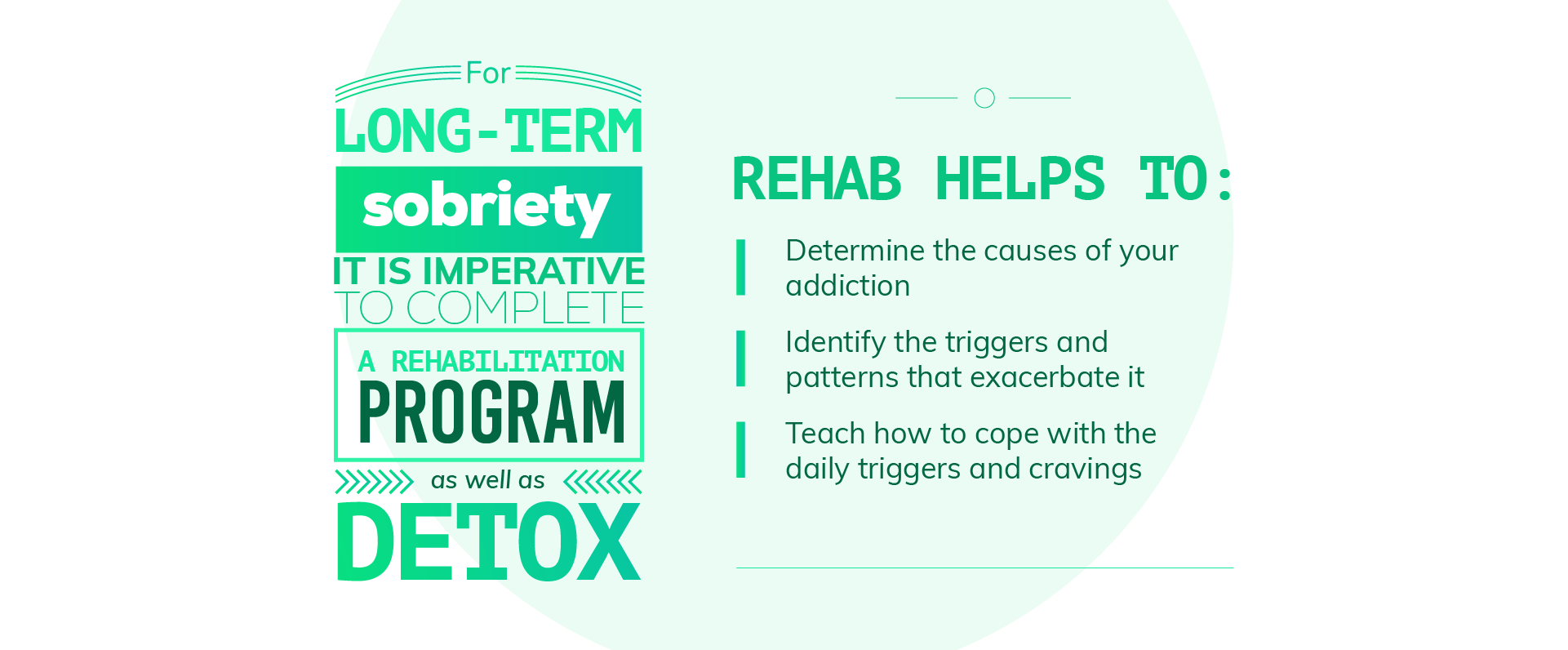
In order to address the psychological side of addiction, it is necessary to explore the causes of your addiction, the triggers and patterns that exacerbate it, and how to cope with the daily triggers and cravings you will encounter in everyday life. This is accomplished through counseling, therapeutic activities, and a range of rehabilitative treatments; in other words - drug or alcohol rehab. At an alcohol or drug rehab facility, you will undergo some combination of the following treatments:
Along with a dual-diagnosis examination and continued medical intervention (if necessary), treatments like those listed above will transform your attitude and approach towards addiction, giving you the tools and insight you need to fight the daily battle that is recovery. Considering that this is a lifelong journey; it makes sense that getting started requires hard work, dedication, and the right set of tools.
Different types of alcohol and drug rehabilitation centers are available at different levels of intensity. The right option for you will depend on the severity of your addiction, your current health status, and your lifestyle. These are some of the most popular options:
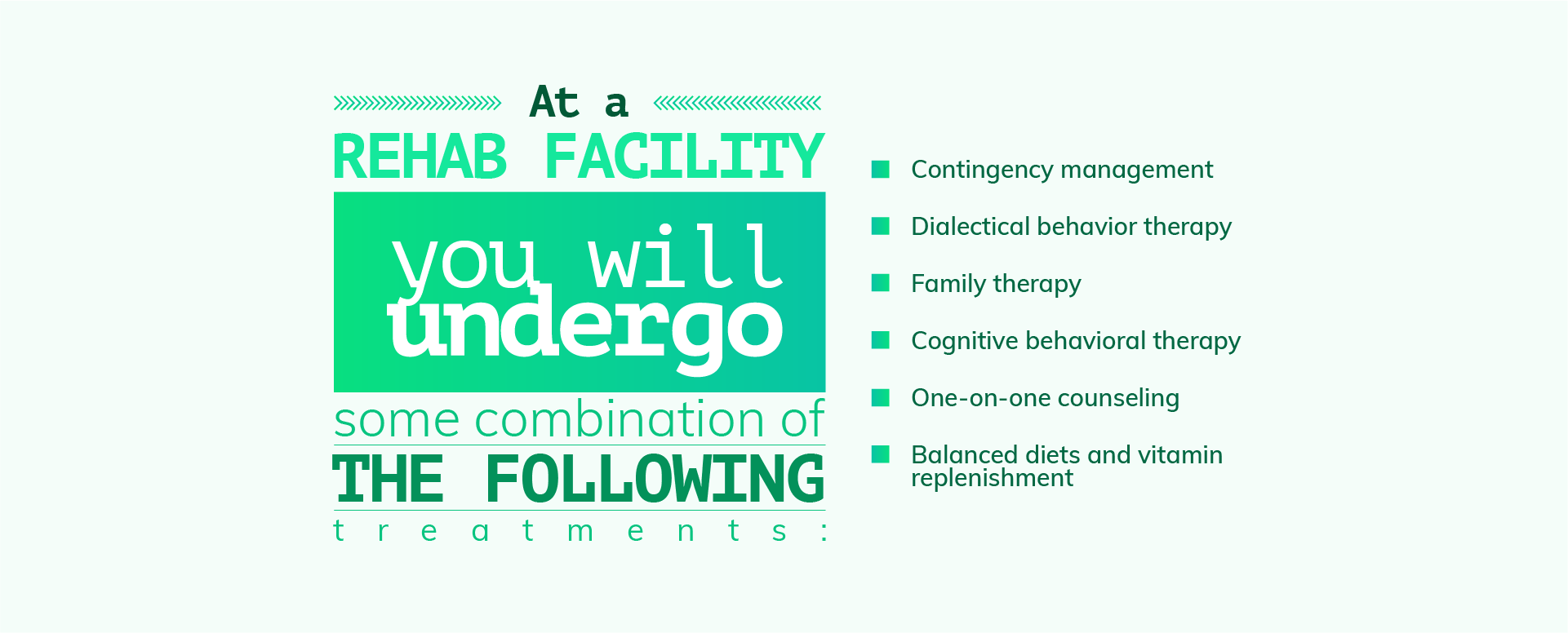

From the outside looking in, many expect detox and rehab programs to work miracles. If a recovering addict is not immediately "fixed" by release day, some critics will assume that the patient or rehab facility failed in some way.
As those unfortunate celebrities who have to suffer through addiction in the world's spotlight will tell you, this is not the case. There is no quick fix for addiction, and a million tabloid covers indicate that this is a disease that affects people of every caste and creed. However, many of those celebrities that have been scrutinized for their addiction have now gone on to live successful, sober lifestyles. Beyond that, millions of normal, everyday people have worked hard and achieved recovery, sometimes after dozens of failed attempts.
"I have completed treatment for alcohol addiction; something I've dealt with in the past and will continue to confront… There is no shame in getting help when you need it, and [I want] to be a source of strength for anyone out there who needs help but is afraid to take the first step... This was the first of many steps being taken towards a positive recovery."
-Ben Affleck
If you have tried and failed to complete detox on your own, or have gone through rehab only to relapse, perhaps it's time to try a comprehensive program that includes medically assisted treatment options. With the right kind of program, you will be equipped with the tools, insight, and coping mechanisms you need to learn how to live a functional and fulfilling life beyond substance use disorder.
The journey doesn't have to end with rehab. Most treatment centers will also provide you with outpatient options as well as recommendations for local support groups and counseling in your local area. Once you begin, your recovery journey will continue for the rest of your life, and there are plenty of resources to help you along the way. A long life of healthy recovery is waiting for you; all you have to do is take the first step and reach out for the help you need.

Our admissions coordinators are here to help you get started with treatment the right way. They'll verify your health insurance, help set up travel arrangements, and make sure your transition into treatment is smooth and hassle-free.
[DirectNumber] Contact Us